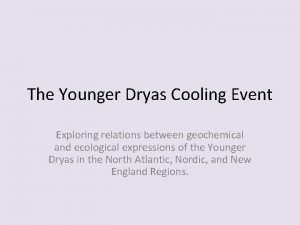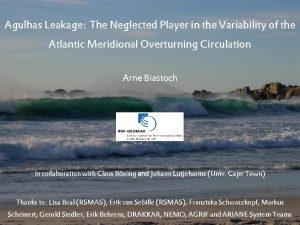Characterizing the Atlantic Meridional Overturning Circulation AMOC M

- Slides: 1

Characterizing the Atlantic Meridional Overturning Circulation (AMOC) M. Baringer, R. Lumpkin, S. L. Garzoli, S. Dong, D. Enfield, G. Goni, G. Halliwell, E. Johns, C. . Meinen, R. Molinari, R. Perez, C. Schmid, C. Thacker and C. Wang (NOAA/Atlantic Oceanographic and Meteorological Laboratory, Miami FL) MOCHA: A North Atlantic overturning circulation observing network What is the Atlantic Meridional Overturning Circulation (AMOC)? In March 2004, an international program began to deploy a system that will continuously observe the meridional mass and heat transport in the subtropical Atlantic. This system will document the variability of the subtropical Atlantic and its relationship to observed climate fluctuations, and the observations will help assess climate model predictions. This program, known as the Meridional Overturning Circulation and Heat-flux Array (MOCHA), includes investigators from the Rapid Climate Change Program funded by the United Kingdom's NERC, National Science Foundation investigators at the University of Miami and NOAA/AOML. 5 Above: Time series of the transport per unit depth profile (10 NOAA/AOML's contribution includes elements of the Global Observing m 2/s) across 26. 5°N in the Atlantic Ocean. The contour System funded by NOAA’s Office of Climate Observations. Of interval is decreased in the lower panel to better illustrate the particular use for MOCHA investigators are (1) transport measurements deep variability. A notable reversal in the deep flow occurs during November 2004 (from Johns et al. , 2008). within the Florida Straits including continuous cable measurements and small boat section estimates, (2) full-water-column hydrographic surveys of the Antilles and Deep Western Boundary Currents and the servicing of moorings, (3) deployment of inverted echo sounder moorings in the western boundary array, and (4) measurements of upper ocean temperature using expendable bathythermographs and profiling floats. The Atlantic Meridional Overturning Circulation (AMOC) consists of northward flow at surface and intermediate depths, and southward flow of North Atlantic Deep Water. The AMOC is a major component of northern hemisphere meridional heat transport, and may fluctuate on a broad range of time scales with significant climate implications. Left: A schematic of the AMOC. Northward flow at the surface (red) and intermediate (yellow) depths ultimately reaches the Labrador, Irminger and Greenland/Iceland/ Norwegian seas where it is converted to bottom (blue) dense water by loss of buoyancy due to intense air-sea heat fluxes. En-route, buoyancy is also lost due to evaporation. The deep water returns southward in a deep western boundary current. Regions where currents break apart, and transport is primarily done by eddies, are indicated by small rotating circles. Above: Evolution of the Atlantic meridional overturning circulation (MOC) at 30°N in simulations with the suite of comprehensive coupled climate models. From IPCC AR 4 (2007), adapted from Schmittner et al. (2005) with additions. The upper limb of the AMOC transports ~1. 2 Petawatts of heat northward at around 24°N in the Atlantic, between 30 -50% of the total heat transport within the ocean-atmosphere system globally at this latitude. This heat is released to the atmosphere primarily at subpolar latitudes. In addition, the sinking water in the northern North Atlantic sequesters a significant fraction of atmospheric greenhouse gases emitted each year, and thus climate sensitivity depends on the strength – and potential variations – in the AMOC. Of particular concern, the high-latitude buoyancy loss can be offset by buoyancy gain from ice melt, which would weaken the AMOC. Above: an inverted echosounder (left) being prepared for deployment, and (right) a CTD being lowered in the water, both measuring the Deep Western Boundary Current east of the Bahamas. The IPCC Fourth Assessment Report (2007) concluded that “Based on current simulations, it is very likely that the Atlantic Ocean Meridional Overturning Circulation (MOC) will slow down during the course of the 21 st century. A multi-model ensemble shows an average reduction of 25% with a broad range from virtually no change to a reduction of over 50% averaged over 2080 to 2099. ” Nevertheless, Atlantic regional temperatures are projected to rise overall due to increased greenhouse gas warming. Argo floats and Expendable Bathythermographs (XBTs) The Ship of Opportunity Program (SOOP) is a component of the Global Ocean Observing System, whose mission is to provide a global platform to deploy and operate and deploy oceanographic instrumentation from cargo ships or research vessels. This program enables the deployment of Argo floats and XBTs to help monitor the upper limb of the AMOC. Below: the Atlantic Ocean Argo array, mid-May 2010 Argo is an international program that oversees an array of 3, 000 free drifting profiling floats, distributed over the global oceans, which measure the temperature and salinity in the upper 2 km of the ocean providing 100, 000 T/S profiles and reference velocity measurements per year. This allows continuous monitoring of the upper limb of the AMOC, with all data being relayed and made publicly available within hours after collection. Future deep-diving Argo floats are being designed to measure the deep bottom waters of the lower AMOC. An XBT is a probe that is dropped from a ship and measures temperature as it falls through the water. The probe is designed to fall at a known rate, so that the depth of the probe can be inferred from the time since it was launched. The data are logged to a computer provided by AOML, where it is processed and formatted for satellite transmission in real-time. NOAA/AOML operates a global XBT program that uses approximately 50 ships of the SOOP to monitor the upper ocean thermal structure along 18 transects in all ocean basins, some of which are climate time series extending back more than 30 years. The high density lines are occupied approximately every three months, with XBTs deployed at ~25 km spacing in order to measure the mesoscale structure of the ocean, to diagnose the ocean circulation responsible for redistributing heat and other water properties. The Expendable Bathythermograph (XBT) Above: location of high-density Atlantic XBT lines maintained by NOAA/AOML Left: Summary of MOCHA components: a trans-basin moored array with clusters at the eastern and western boundaries and Mid-Atlantic Ridge, transbasin and western boundary repeat hydrographic sections, Florida Current monitoring by submarine cable, weekly current profile sections, and quarterly CTD/LADCP sections, and quarterly highresolution XBT sections from Gibraltar to Miami. Observing the South Atlantic MOC The South Atlantic Meridional Overturning Circulation Program (SAM), which began in 2009, seeks to capture key components of the AMOC in a hitherto undersampled region - the South Atlantic Ocean. Numerical climate models have indicated that important water mass transformations are undergone by the AMOC flows in the South Atlantic, however little data has previously been available for the study of these flows. The initial array deployed as part of the SAM project involves a zonal line of three pressure-equipped inverted echo sounders (PIES) and one current-and-pressure-equipped inverted echo sounder (CPIES) deployed near the western boundary at 34. 5°S. Data from these instruments will be used to monitor the Brazil Current and the Deep Western Boundary Current as they carry components of the AMOC along the western boundary of the basin. Coupled with annual or semiannual hydrographic observations collected on an Argentine or Brazilian research vessel, these data will produce better understanding of the processes involved in AMOC variability in the South Atlantic. Above: locations of the four PIES/CPIES instruments deployed as part of the SAM project. Also shown (blue arrows) are the near-surface velocities observed by the shipboard-ADCP onboard the Brazilian Navy research vessel Cruzeiro do Sul during the March 2009 deployment cruise. Below: Map of the South Atlantic and Southern Ocean, including the two principal choke point regions, the Drake Passage and south of South Africa, with the current and proposed locations of instrument deployments and the institutes leading the corresponding associated projects. From Speich et al. (2009). Researchers at NOAA/AOML are also examining historical data and existing model output, and are conducting Observing System Simulation Experiments (OSSEs) and Observing System Experiments (OSEs), to determine optimal observing system strategies to monitor changes in the South Atlantic MOC, along with future expansions of MOCHA.

